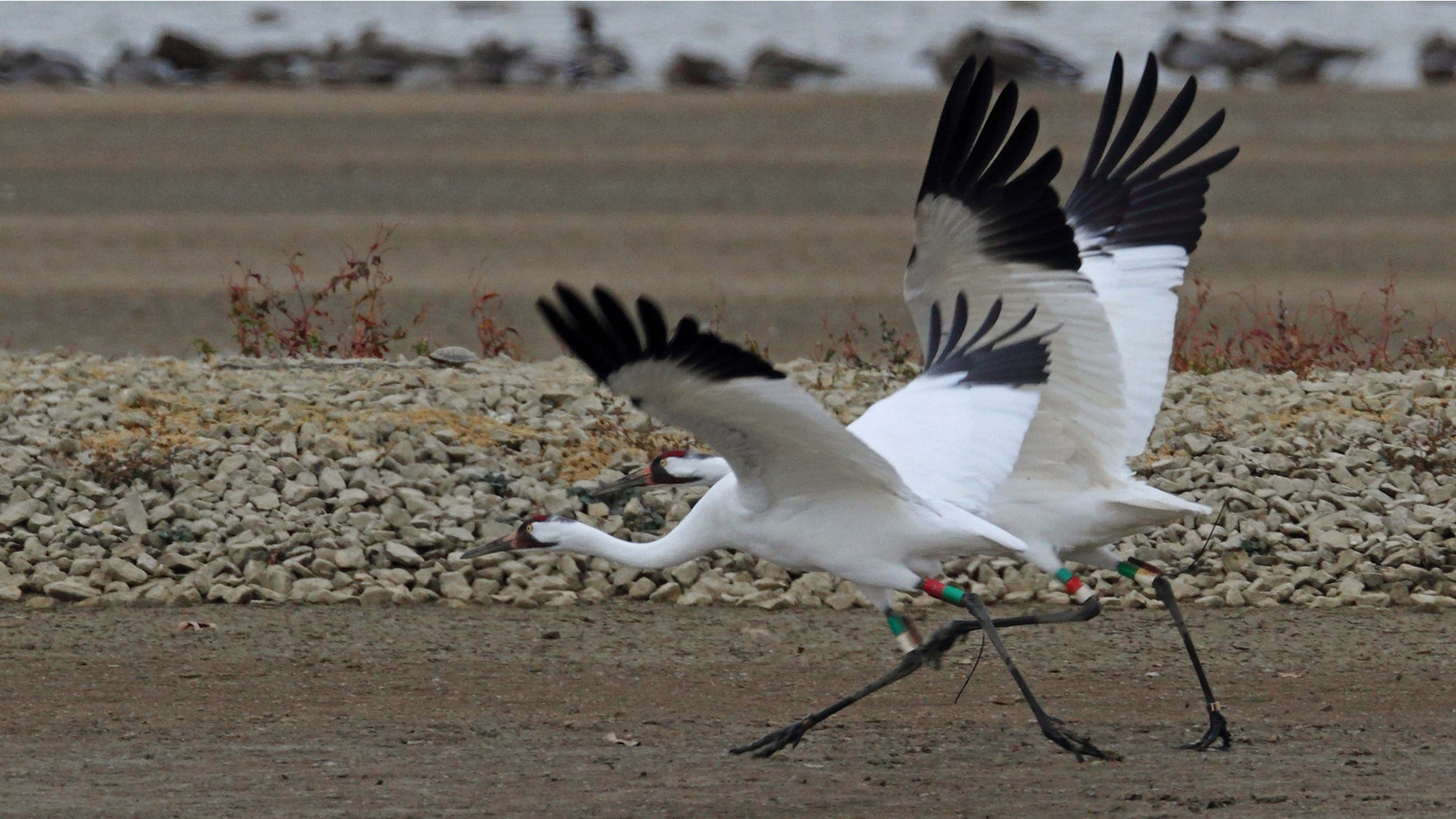North America’s tallest birds could be wiped out by one of the world’s biggest threats.
Whooping cranes (Grus americana) famously barely escaped extinction during the 20th century. After decades of habitat loss and unrestricted hunting, their population had crashed to just 15 birds in 1941. Today, thanks to intense captive-breeding programs and the protection of the Endangered Species Act, that number has soared to approximately 500 wild birds. Their seven-foot wingspans are once again visible in the sky as they migrate between their summer breeding grounds at Wood Buffalo National Park in Canada and their wintering grounds in the southern United States.
But those cranes’ breeding grounds may be at risk. According to research published recently in the journal Ecology and Evolution, climate change could cause the whooping cranes’ wetland breeding habitats in Canada to dry up just enough by the year 2050 to allow predators to access the birds’ shallow-water nests and precious eggs and hatchlings. According the paper, authored by researchers from the U.S. Fish and Wildlife Service, the loss of just one juvenile crane per 200 adults would be enough to cause the wild population to start declining once again.
“[Any] perceptions that whooping cranes remain secure in Canada, and can remain free of active management, are false,” the researchers wrote. They added that if attempts to manage this climate threat are not successful “then the only wild population of this species must adapt or likely face extinction.” (Lead author Matthew Butler of the Fish and Wildlife Service declined to comment for this article.)
Why would climate change be so disastrous for this species? It all boils down to whooping cranes’ biology and behavior, explains Dr. Richard Beilfuss, President and CEO of the International Crane Foundation, one of several organizations partnering to conserve the species (Beilfuss is not affiliated with the new study).
“Whooping cranes only raise one chick a year except in extreme cases,” he says. “There’s pretty high vulnerability of that chick to predators, so their recruitment is naturally low overall and it makes recovery very challenging.”
By comparison sandhilll cranes (G. canadensis), which often have overlapping habitats with whooping cranes, tend to have a couple of chicks per year and are better at protecting their eggs from predators. “They’re better hiders,” Beilfuss explains. This has allowed their population to withstand some of the same pressures faced by whooping cranes.
Given their biological and behavioral limitations, whooping cranes have done remarkably well since they returned to their native habitats over the past few decades. Beilfuss says their numbers continue to rise, and the current target is to achieve about 200 to 250 breeding pairs and around 1,000 overall birds in the wild. “Until we reach that magic number, we’re going to feel that they’re still really vulnerable, even though their populations are increasing.”
Although the paper concentrates on the effects of climate change in Canada, the rest of whooping cranes’ range could also be affected, something illustrated by previous FWS research. “My personal feeling is our biggest worry on climate change is still related to maintaining conditions on their wintering grounds,” Beilfuss says. “I’m very concerned about the combination of water-use decisions and reduced water correlating to more prolonged drought in the southwest U.S.”
In fact, he says, the effects of climate change are already being felt to a degree by all of the world’s 15 crane species, which are experiencing increased droughts and more extreme rainfall. Heavy rains might sound like a good thing for wetlands-dependent species, but it doesn’t quite work that way. “Water will run off more quickly into rivers and run down to the sea but not be in the landscape for as long where the cranes need it,” Beilfuss says, pointing out that these heavy strains are already affecting crane species in northeast China, northwest India and southern Africa.
Other threats loom, particularly for whooping cranes, which could be all but wiped out by a single disaster. “For example, we were very fortunate that the BP oil spill happened during their non-breeding season and off of Louisiana,” Beilfuss says. “If a similar spill had happened closer to Texas in the winter, then it could have contaminated their entire coastal range.” Getting the population higher, he says, would allow the species to withstand an impact like that while continuing to grow their population.
Although the climate change predictions in the new paper are fairly apocalyptic, Beilfuss says it doesn’t mean that whooping cranes are necessarily doomed. “They’re pretty resilient birds,” he says. “They’ll probably find some alternative ways to get by as long as there’s a reasonable amount of water on the landscape.” He adds, though, that “conditions are going to be worse and worse” and that the new paper illustrates the need to be concerned about whooping crane productivity in the United States and in Canada if we hope for these magnificent birds to keep flying the skies of both nations.


